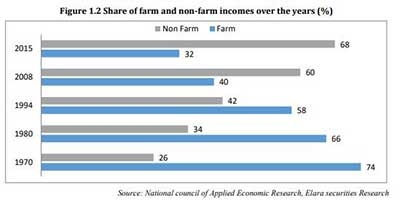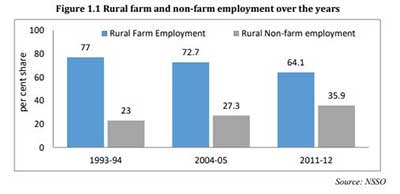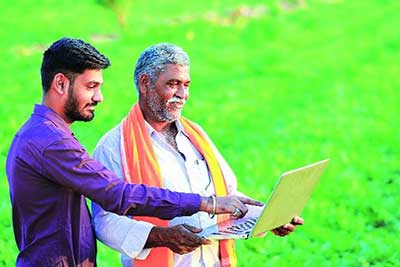Relevance: GS-3: Agriculture, Conservation, Food processing and related industries in India- scope and significance.
Key phrases: secondary agriculture, income generating activity, TACSA in 2007, Value-addition, Food processing, non-farm produce.
Why in News?
- Instead of focussing on the old mandate of just providing food and fodder, a shift towards employment and better income is important as agriculture has new and emphatic demands now, said Ashok Dalwai, chairman of the committee on doubling farmers’ income.
What is Secondary Agriculture?
- Secondary Agriculture is defined as a production activity and devised a strategy that includes sustainability of production, monetization of farmer's produce, straightening of extension service, and recognizing agriculture as an enterprise.
- Any activity on the farm that is done beyond the kharif, rabi and zaid seasons is secondary agriculture i.e. Income-generation activities that use crop residues -- paddy straw, fodder blocks and crop residue briquettes.
- The term ‘secondary’ has a bearing on climate change adaptation and its mitigation, small farm viability and profitability, food security, nutrition, sustainable utilisation of natural resources, and optimal usage of produce from primary agriculture and farm incomes.

Trend of Primary Agriculture (farm activities) and Secondary Agriculture (non-farm Activities):


How would Secondary agriculture supplement farmers’ income?
Secondary agriculture, as is defined, can help drive the growth of primary agriculture, and three avenues have been identified that adequately help utilise capital, human resources, technology, organisational capabilities, and risk management:
- Value-addition to primary agriculture production systems: It can be achieved by improving livelihood enhancement action plans that are implemented by farmer-based/community-based organisations. Linking farmers with the market through aggregation and assaying/grading of agricultural produce can help them in value enhancement and appropriation. Collectivisations, cluster farming, financial literacy, marketing skills are important to build this avenue.
- Alternative enterprises, but linked to rural off-farm activities: It is based on utilisation of alternative enterprises to primary agriculture, but is associated with rural off-farm activities. For example, poultry, bee-keeping, duck farming and livestock management are off-farm enterprises that can be promoted as part of integrated farming system. Integrated farming can hedge farm risk in the period of crop failure, or ease out the seasonality in the stream of cash flows.
-
Enterprises that thrive on crop residues and waste materials of primary agriculture: These are such enterprises that strive on crop residues, or by-products of primary agriculture. For example, after recovering sugar from cane, cane can be used as bagasse for molasses production. Similarly, cotton stalk and seed (after ginning) can be used for de-oiled cake preparation or utilised in the secondary/tertiary sector.
Government Initiatives
- The Technical Advisory Committee on Secondary Agriculture (TACSA) in 2007 was constituted by the Planning Commission to address these issues and find workable solutions that can serve as catalysts to fuel private sector activities in this important area.
- TACSA proposed a sum of $2 billion be invested by the Government to jump-start the secondary agriculture activities as follows:
- This investment, Secondary Agriculture Improvement Fund (SAIF), is to be treated as venture capital with expected returns in a defined time;
- An investment of $200 Million in developing the bioprocessing infrastructure, including building an integrated Bioprocessing Technology institute (IBTI);
- An investment of $100 Million coupled with additional private Angel Funds of $100 Million for early stage concept development and proof of concept generation in specific promising bio processing technologies;
- An investment of $700 Million to be coupled with private venture funds for small company development (minimum of 1:1 matching and up to 1:4 matching of SAIF Private Funds).
- An investment of $1 Billion for project financing to be coupled with private funds of $2-3 Billion.
Some Recommendations for driving the growth of Secondary agriculture:
Recommendations for driving the growth of primary agriculture through secondary agriculture are as under:
- The strengthening and expansion of secondary agriculture and its linking to primary agriculture is crucial. The nexus involving research institutes – bio resource industries – financial institutions – farmers’ organisation should be strengthened. The focus of ICAR and SAUs need to be changed to include crop processing and value addition.
- Encourage Private-Public-Partnership (PPP) so that the technology development, commercialisation and transfer and investment requirement for the growth of secondary agriculture are adequately met. In the process, the Government should be the facilitator, rather than a controller with minimum bureaucratic hurdles.
- Enabling rural industrialisation is key to link on farm and off-farm activities. This provides ample opportunities for non-farm employment.
- Capacity building of educated farmers on secondary agriculture through training, vocational programmes, diploma and certificate programmes is essential, so that they acquire the required skills and knowledge for employment in the rural industries.
- Provide technical and financial support to viable farmers’ organisations such as co-operatives, associations and self-help groups to form producer companies so that they can undertake secondary agriculture along with primary agriculture.
- Secondary agriculture related activities are spread over several ministries in central and state Governments. It is necessary to have a nodal agency to coordinate all the activities.
- The curricula at SAUs should include secondary agriculture, bioprocessing technologies and agribusiness courses so that we have the right human resources to manage secondary and primary agriculture. In the process SAUs should offer diploma/certificate programmes as for the demand of secondary agricultural sector.
Way forward:
- Secondary agriculture has all the potential to drive the growth of primary agricultural sector in the country. We have to take more research in secondary agriculture so that the Indian agriculture moves forward with higher growth rates.
Source: The Hindu BL
Mains Question:
Q. Ashok Dalwai chairman of the committee on doubling farmers’ income, was of the view that primary agriculture alone cannot generate adequate incomes for farmers. In the context of the statement discus the scope of secondary agriculture to doubling farmer income? Also suggest key measures for boosting secondary agriculture activities in rural area of India? Critically Examine.







